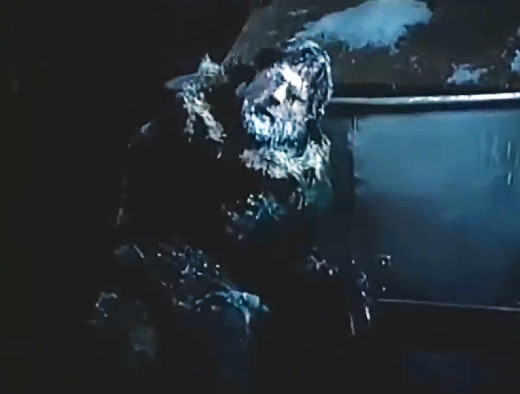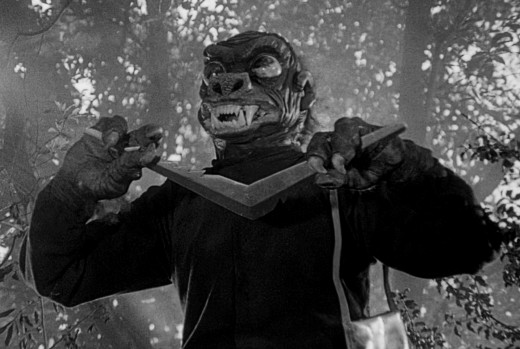Pros: Establishes a dark, moody atmosphere and nicely ratchets up the tension; the leads are absolutely believable as two men trying to hold onto their sanity
Cons: Occasional clumsy bits of dialog
This suspense-thriller starts off very much like an Outer Limits episode -- Mr. “Control Voice” voice himself, Vic Perrin, narrates (in voiceover) the recent history of a remote mountain research station as we see a helicopter delivering a new pair of scientists to the station in the middle of a snowstorm.
The facility, located at the permanently snowy peak of Tower Mountain, is being used to house chimpanzees and monkeys involved in space medicine research, testing the limits of primate endurance under extreme conditions. (My biggest beef with the movie is that you don’t need to locate your lab on top of a nearly inaccessible mountain to simulate extreme conditions for experimental purposes, but we’ll set that aside for now.)
Regular contact with the sole scientist running the lab, Dr. Vogel, has been lost, and in his last communication, the man seemed to be losing his mind, insisting that he had been talking with Alexander the Great and Napoleon.
The replacement team, Robert Jones (Robert Culp) and Frank Enari (Eli Wallach) find the facility in total chaos, equipment and papers scattered, the heat off, and the monkeys nearly frozen to death in their cages. Most horrific, they find Vogel completely frozen in a chair in the electronics room, a nearby window open to the elements.
 |
| The replacement team gets a chilly reception at the research station. |
After restoring heat and order to the facility, Robert and Frank resume the experiments (apparently the show must go on). But soon, a series of incidents -- the monkeys screaming in the night, equipment mysteriously turned on, windows opened and the generator turned off by an unseen hand, food stores ripped apart and scattered across the kitchen -- cause the two scientists to turn on each other. Or is there someone or something else hiding out at the station?
A Cold Night’s Death is dark and chilling (no pun intended). After the departure of the helicopter pilot, the movie is all Culp’s and Wallach’s, and the two veteran actors do a superb job of gradually surrendering their characters to paranoia and suspicion.
There are some awkward moments. Twice in the 70 minute long movie, Frank talks at length about how he is a by-the-book type who just wants to keep his head down and do the work, while Robert is an intellectual dreamer who needs mysteries and challenges to stay engaged. Under the circumstances, it’s not necessary for the two men to have such wildly divergent personalities to begin suspecting one another, but the dialog hammers the point home.
 |
| Frank and Robert wonder who's been monkeying around with their stuff. |
It’s enough that the characters demonstrate their differences by their actions: Robert goes into detective mode, wondering why Vogel shut himself up in the only room that could be locked from the inside to freeze to death, while fussy Frank immerses himself in finishing the experiments, cooking the meals and pretending nothing out of the ordinary is happening (until, as things get really bad, he becomes convinced that Robert is off his rocker and staging everything).
While there are subtle clues dropped throughout, many viewers will probably still be surprised by Robert’s late epiphany regarding the locked electronics room and Vogel’s last, crazy communications with the outside world -- not to mention the surprise ending.
In his book Television Fright Films of the 1970s, David Deal praises A Cold Night’s Death, calling it “...one of the leanest telefrights of the era. It is essentially a two-man show and the bulk of the action takes place on a single set. Regardless, it is a crackerjack production boasting a tight script, good acting and a feel for psychological isolation.” He also relates that screenwriter Christopher Knopf earned an Edgar Award nomination from the Mystery Writers of America for his efforts. [McFarland, 2007, p. 18.; see also my review of the book on this site]
At this point in his career, Robert Culp was no stranger to TV sci-fi, having appeared in no fewer than 3 episodes of The Outer Limits series (including the Harlan Ellison-scripted fan favorite Demon with a Glass Hand). Later in the ‘70s he played an occult investigator in Spectre (1977), a Gene Roddenberry TV pilot that went nowhere but has since earned a minor cult reputation.
 |
| Public Service Announcement: When shoveling snow, don't overdo it. |
Eli Wallach of The Good, the Bad and the Ugly fame (1966) spent the ‘70s appearing in a succession of smaller films and TV movies and series, with occasional stopovers in Italy to do westerns and suspense thrillers. One of his oddest roles was as “the man in oil” in the David Carradine martial arts fantasy-adventure Circle of Iron (1978).
Where to find it: A watchable copy can be streamed here.













